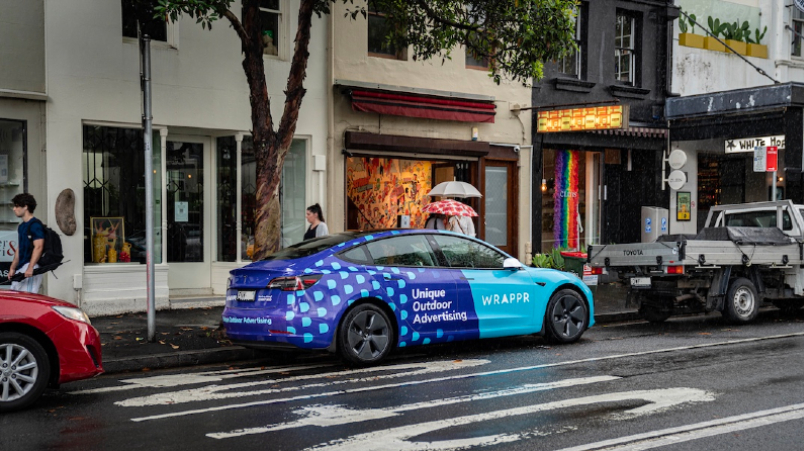299% growth year-on-year for out-of-home firm Wrappr, Woolies, eBay, Catch, Doordash piling in as it lands Bcorp rating

Out of home company Wrappr has become a B Corp, scoring 84.9 on the B Lab certification.
Woolies, eBay, Catch, Doordash and Dan Murphy’s are spending “six or seven figures” on ongoing out of home brand campaigns that have no billboards, no digital screens or panels. Instead, they are paying thousands of Australians to wrap their cars, vans and utes with brand messages – and Wrappr, Australia's latest Bcorp, says demand is booming, with revenues up circa 300 per cent.
What you need to know:
- OOH firm Wrappr sees booming brand demand and willing vehicle owners - paying them up to $500/month to wrap their cars with brand ads.
- But they get penalised if they drive badly.
- Wrappr has just become a Bcorp after a 12-month process.
On the fifth page of Wrappr’s pitch deck is Marshall McLuhan’s quote that ‘the medium is the message’. But instead of television, newspapers or radio, Wrappr’s medium is a Toyota or a Tesla. Or just about anything else on wheels. The out of home company puts ads on cars and gives them a cut of the brand dollar.
In effect, major brands like Woolies, eBay, Catch, Doordash and Dan Murphy’s are spending “six or seven figures” on ongoing out of home brand campaigns that have no billboards, no digital screens or public transport panels, per Wrappr co-founder Jonte Shaw. Wrappr’s revenue in the 2022 financial year rose 299 per cent compared to 2021. While Covid tends to make year on year comparators look good, brand appetite is fuelling growth – and there are no shortage of people willing to have their car wrapped in return for $500 a month. But that's if they drive well. If they drive badly, they get less cash.
Targeted reach
Shaw, who launched Wrappr with his brother Liam in 2017, said it was about turning cars into “high impact, high reach brand assets” in a way that can be targeted to specific towns and regions.
“We have been able to run campaigns anywhere in Australia from day dot, which is one of the amazing things about the model – a sharing economy business. Pretty much any town with more than 10,000 people, we’ve able to find advocates,” Shaw said.
“We’ve got a national network of wrap production and installation workshops, we can cover 90 per cent of the Australian population, which is quite different to the traditional out of home model where you have to purchase the assets. To grow you need to purchase the assets. Our assets are anyone who drives a vehicle.”
Wrappr has just become a Bcorp, with a score of 84.9, meaning it has been reviewed by B Lab and found to be meeting a high standard of social and environmental performance, accountability and transparency. It was a 12-month process, Shaw said, but since the company was founded in 2017 – as a hobby – and started accelerating in 2020, it was already operating in a way that met most of B Lab’s criteria. Wrappr offsets twice the carbon emitted by its drivers through a partnership with Greenfleet, but it had no firm parental and compassionate leave policy – it hadn’t needed them. It is the second media owner to become a Bcorp, after social platform WeAre8.
No VCs
The company is profitable and hasn’t needed to go out to venture capital firms for additional funding – and in fact is strict about the brands it chooses not to work with. In order to get good results, its drivers aka advocates need to give the brand they represent a nine or 10 Net Promoter Score (out of 10).
Brands can buy anything from a full wrap, a partial wrap, a side door or even a message on a rear windscreen. Drivers can earn $500 a month – with another $100 if they drive an electric vehicle. About one in 25 of Australia’s Teslas are part of the Wrappr network.
The average campaign runs from six to eight months, with evergreen brand messages. “It is relatively inexpensive to keep the vehicles on the road once they’re there,” Shaw said.
“There is a significant always on element that can come into these campaigns. It’s somewhere between a subscription and campaign model.”
An app logs when and where advocates are driving and scores them on the safety of their driving – speed, acceleration, cornering and mobile phone use, for example. Drivers must keep a safety score above 90 out of 100 or they get penalised. Earlier in the year, Wrappr launched a measurement platform, LIFT, that anonymously pings nearby smartphones and, working with Nielsen, calculates behaviour compared to a control audience.
